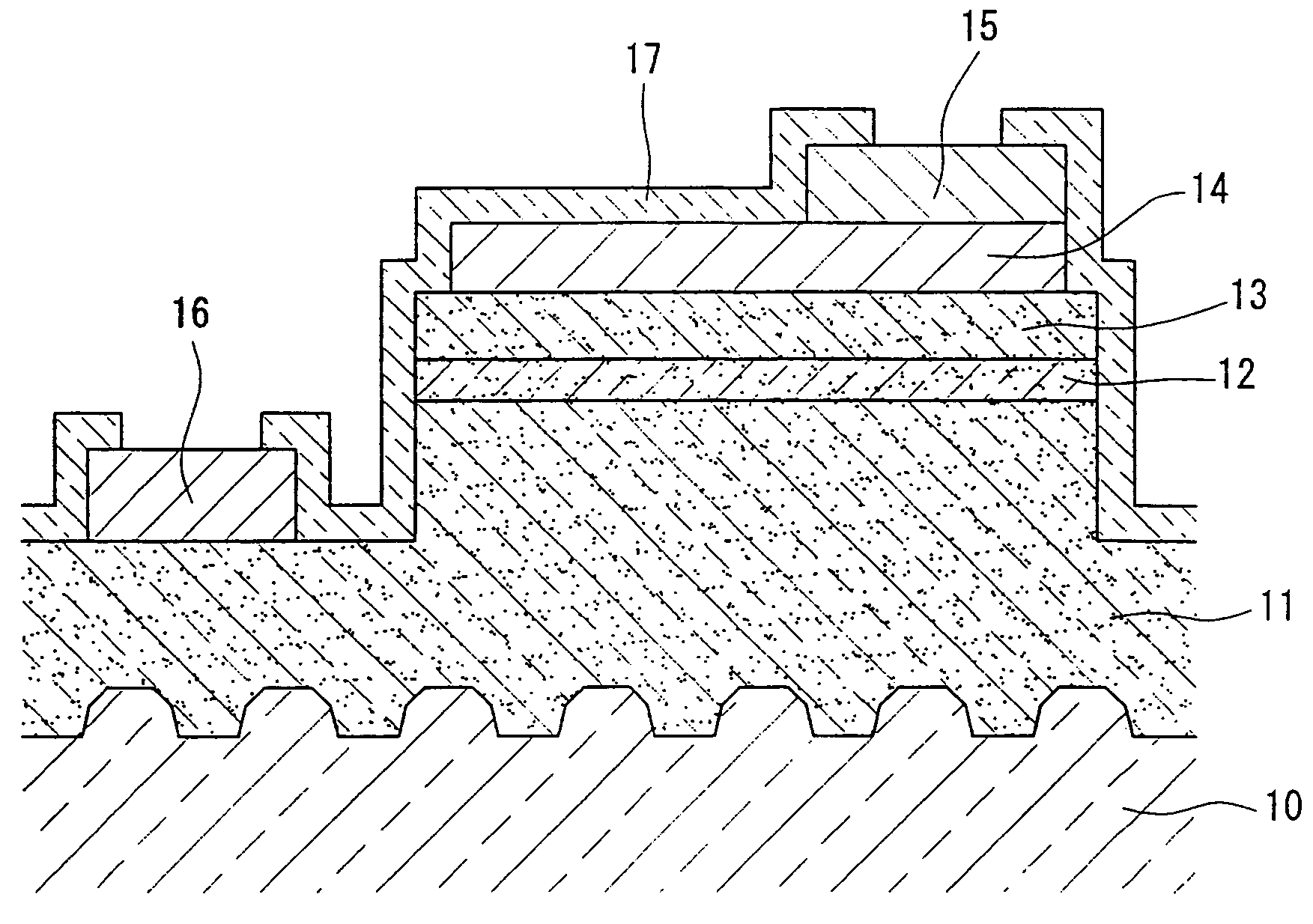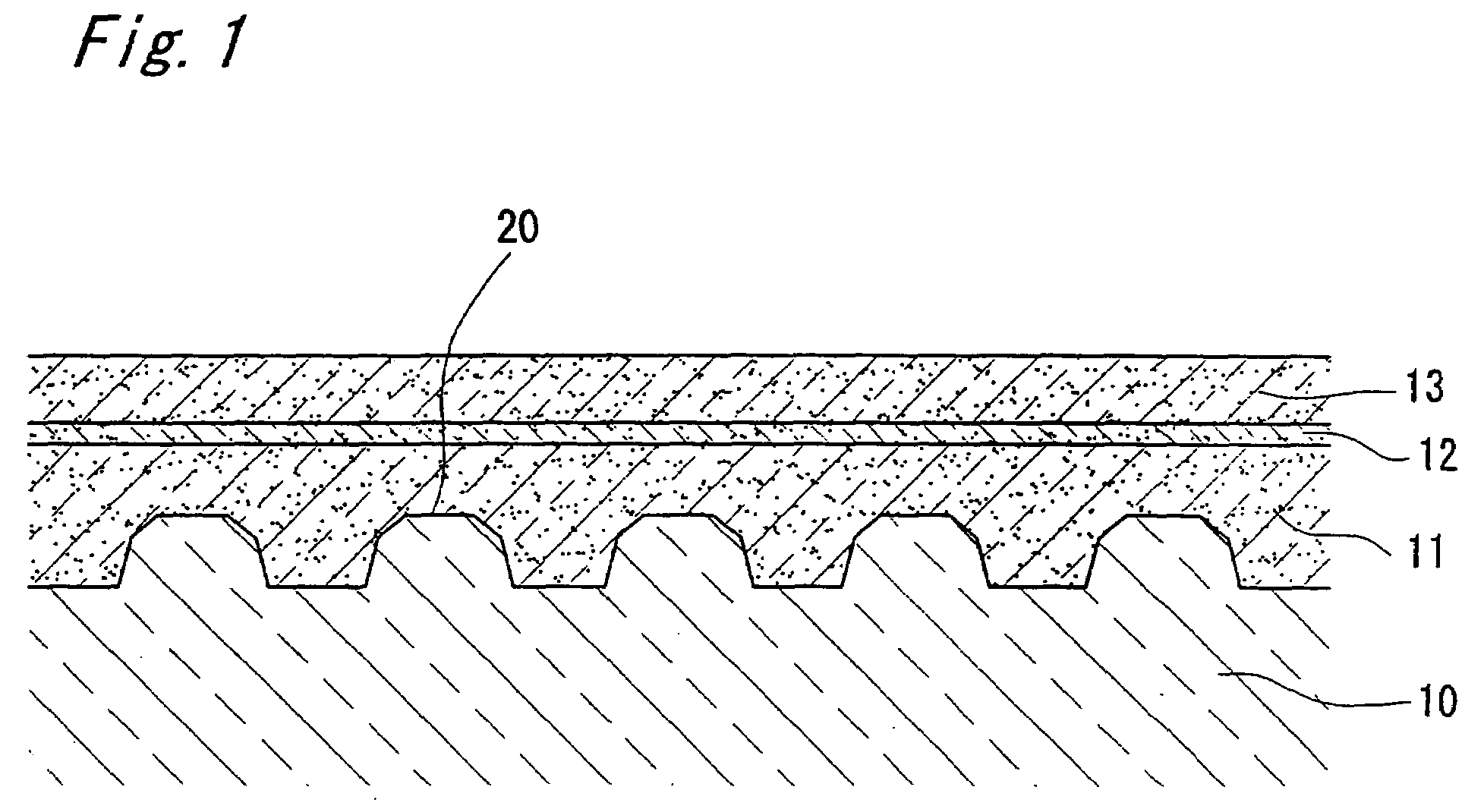Semiconductor light emitting device with protrusions to improve external efficiency and crystal growth
a technology of semiconductor devices and protrusions, applied in semiconductor devices, semiconductor/solid-state device details, electrical apparatus, etc., can solve the problems of reducing the efficiency of external quantum energy, reducing so as to reduce the crystallinity of gan, reduce the efficiency of light emission, and facilitate cracking
- Summary
- Abstract
- Description
- Claims
- Application Information
AI Technical Summary
Benefits of technology
Problems solved by technology
Method used
Image
Examples
embodiment 1
[0109]In a first embodiment of the present invention, the side face of the protrusion consists of at least two sloped surfaces (first sloped surface 22, second sloped surface 23) as shown in FIG. 4A and FIG. 5A. An inclination angle θ2 on a top face side of the protrusion is smaller than an inclination angle θ1 on a bottom side. The inclination angle θ is an angle between the side face and a bottom of the protrusion. In case recesses are formed in the substrate, an inner wall of each recess is also formed so that the inclination angle θ2 of an upper inner wall is larger than an inclination angle θ1 of a lower inner wall. The inclination angle θ1 of the inner wall is a complementary angle of angle Φi between the inner wall and a bottom surface of the recess.
θi=180°−Φi (i=1, 2)
When inclination angle θ3 is defined as an angle between the top face and the side face of the protrusion, in case the top face is substantially parallel to the substrate surface, angle Φ2 between the upper inne...
embodiment 2
[0110]In a second embodiment of the invention, a side face of the protrusion is formed as a curved surface. In case an entire side face of the protrusion is formed of a single curved surface, a radius of curvature may be made larger on a top face side and smaller on a bottom side.
[0111]Alternatively, such a configuration may also be employed as the bottom side being flat, i.e., an upper side of the side face is curved and the lower side is flat. Moreover, a plurality of curved portions and a plurality of flat portions may be formed on the side face of the protrusion. For example, in a structure of the first embodiment where the first and second sloped surfaces are formed, the second sloped surface may be formed as a curved surface with the first sloped surface consisting of a substantially flat surface. A condition of the side face may be selected as required in accordance with substrate material, an etching condition, material of a semiconductor layer and other factors.
[0112]It is ...
embodiment 3
Structure of Light Emitting Device
[0113]Constitution of a semiconductor light emitting device according to the present invention will be described in detail. There are no specific requirements for a size and thickness of the substrate 10 which may be of any constitution as long as it allows epitaxial growth of a semiconductor thereon. The substrate used to grow a nitride semiconductor thereon may be made of an insulating material such as sapphire or spinel (MgAl2O4) having a principal plane as a C plane, R plane or A plane, or an oxide such as lithium niobate or neodymium gallate that forms a lattice junction with silicon carbide (6H, 4H, 3C), silicon, ZnS, ZnO, Si, GaAs, diamond, or oxide substrates such as lithium niobate or neodymium gallate, which can provide a good lattice match with a nitride semiconductor. A substrate made of a nitride semiconductor such as GaN or AlN may also be used provided that it is thick enough to form devices thereon (over several tens of micrometers)....
PUM
 Login to View More
Login to View More Abstract
Description
Claims
Application Information
 Login to View More
Login to View More - R&D
- Intellectual Property
- Life Sciences
- Materials
- Tech Scout
- Unparalleled Data Quality
- Higher Quality Content
- 60% Fewer Hallucinations
Browse by: Latest US Patents, China's latest patents, Technical Efficacy Thesaurus, Application Domain, Technology Topic, Popular Technical Reports.
© 2025 PatSnap. All rights reserved.Legal|Privacy policy|Modern Slavery Act Transparency Statement|Sitemap|About US| Contact US: help@patsnap.com



